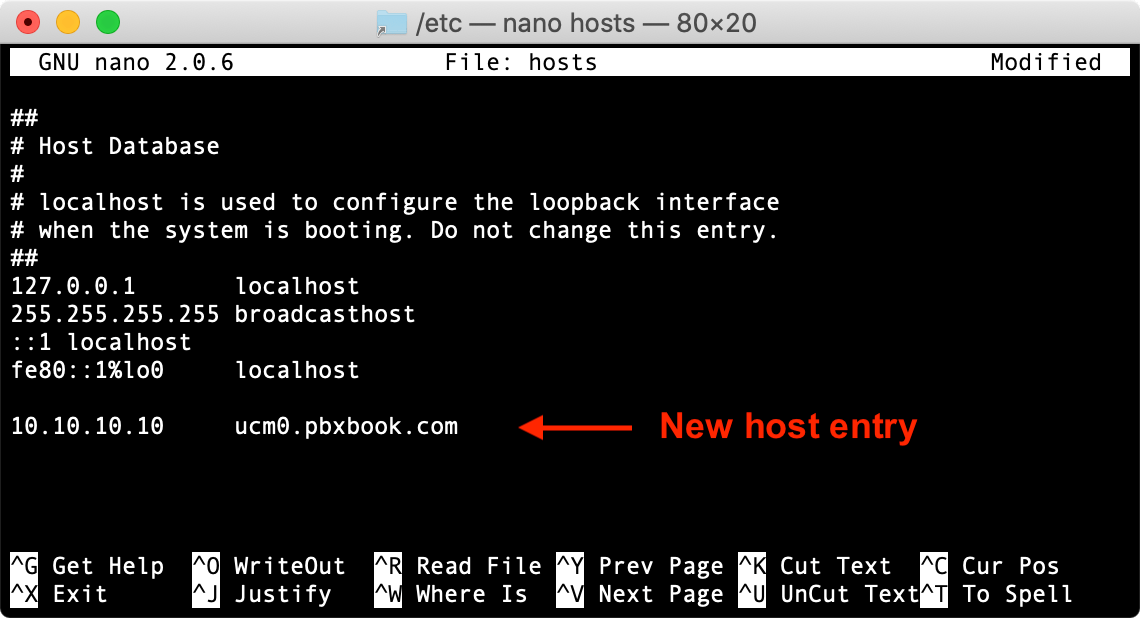Filed Under: How to, OS X Tagged With: block hosts, Edit Hosts El Capitan, edit hosts file, hosts, hosts file location el capitan, OS X 10.11, OS X 10.11 El Capitan, OS X El Capitan Special Offers Game Developer and Player Bundle Ft. PlayStation Plus for $99.
The Mac OS X hosts file Introduction. Doesn't have an extension, its just called hosts. Is a text file that maps hostnames to IP addresses. Is located at /etc/, which is a symbolic link to /private/etc/ is checked before the active network connection's DNS servers. Plays an important role in managing an Avaya 7.5 system (and. Using the built-in SSH client in Mac OS X. Mac OS X includes a command-line SSH client as part of the operating system. To use it, goto Finder, and selext Go - Utilities from the top menu. Then look for Terminal. Terminal can be used to get a local terminal window, and also supports SSH connections to remote servers. How to reset your Mac's Hosts file. When you're ready to undo your changes and restore where your Mac's Hosts file routes to, you can do so by replacing the current host file with a new set of terms. You don't need Terminal for this reset. Make sure Finder is selected on your Mac. Click on Go in the Mac menu bar. Click on Go to Folder. Edit Hosts File On Mac. It’s fairly easy to edit the hosts file on your Mac since there’s a built-in editor to do it. It’s located inside the Terminal and is called nano editor. You can use it to open and edit any text file including the hosts file on your machine. Make sure you’re using an admin account to do the following steps.
- 1QEMU on OS X (macOS) hosts
While QEMU's main host platform is Linux, it is also supported on operating systems for Apple's Mac computers (known as OS X or macOS). The official support policy covers the last two released versions of OSX; QEMU might work on older versions, but it is not guaranteed and it might not even compile on older versions.
Please note that fewer developers work on QEMU for Mac hosts, so it might be less stable (but I don't think it is). If you can replicate a bug on a Linux hosted QEMU before reporting it, this is helpful as it means a wider set of people might look into it.
Some system emulations on Linux use KVM, a special emulation mode which claims to reach nearly native speed.KVM is mainly used for x86 (32 and 64 bit) emulation on x86 hosts running Linux. Should you want to run Qemu with KVM support on a G5, depending on your distribution, you might have to compile your own kernel with KVM support.There exists a port of QEMU to Hypervisor.framework (a kernel module from Apple which is similar in spirit to KVM), but unfortunately it is not included in upstream QEMU.


Building QEMU for OS X
The system requirements are:
- One of the last two most recent versions of OS X (currently that's 10.13 or 10.14)
- The clang compiler shipped with the version of Xcode for that OS X. GCC might also work, but we recommend clang
Additional build requirements are:
You may find it easiest to get these from a third-party packagersuch as Homebrew, Macports, or Fink.
After downloading the QEMU source code, double-click it to expand it.
Then configure and make QEMU. The target-list option is used to build only the machine or machines you want. If you don't specify it, all machines would be built. Probably not what you want.
This way doesn't require you to wait for the configure command to complete:
If your system has the 'say' command, you can use it to tell you when QEMU is done
You can use './configure --help' to see a full list of options.
Here are all the currently available machines:
- aarch64-softmmu
- alpha-softmmu
- arm-softmmu
- cris-softmmu
- i386-softmmu
- lm32-softmmu
- m68k-softmmu
- microblaze-softmmu
- microblazeel-softmmu
- mips-softmmu
- mips64-softmmu
- mips64el-softmmu
- mipsel-softmmu
- moxie-softmmu
- or32-softmmu
- ppc-softmmu
- ppc64-softmmu
- ppcemb-softmmu
- s390x-softmmu
- sh4-softmmu
- sh4eb-softmmu
- sparc-softmmu
- sparc64-softmmu
- tricore-softmmu
- unicore32-softmmu
- x86_64-softmmu
- xtensa-softmmu
- xtensaeb-softmmu
We recommend building QEMU with the -default compiler provided by Apple, for your version of Mac OS X (which will be 'clang'). The configure script will automatically pick this.
Hosts For Mac Os X 10.10
Errors on old compilers


Note: If after the configure step you see a message like this:

you may have to install your own version of gcc. You can build it from source (expect that to take several hours) or obtain third party binaries of gcc available from Homebrew or MacPorts.
You can have several versions of GCC on your system. To specify a certain version, use the --cc and --cxx options.
Build with LLVM/Clang 7
If you need to compile with newer versions of clang (to get f.i. AVX/AVX2 support), you can install llvm through e.g., brew.
Note that building for machines with CPUs supporting such extensions will exclude running your binary on earlier machines.
Compile with:
Contacts
If there are any issues with this web page, please let me know.
Hosts For Mac Os X 10.13
Hosts For Mac Os X 10.8
Finder -> Go -> Go to Folder...
and enter
which is tildaslash.ssh
If you want to use the Terminal, then you would
You can use something like TextEdit, TextWrangler, Smultron to edit the file. If using the terminal you can use nano, vi, vim, emacs to edit the file.
The only problem with some of these editors is finding an explicit line. As I seem to recall, the known_host file message gives a line number. Since the lines in the known_hosts file are very long, a lot of these editors line wrap so just counting visible lines is not accurate.
Message was edited by: BobHarris
Hosts For Mac Os X 10.7
Jan 11, 2009 1:43 PM
